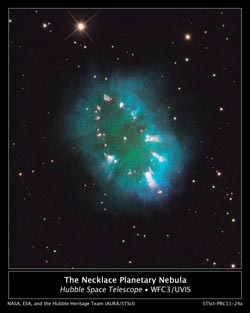Hubble Offers a Dazzling View of the 'Necklace' Nebula

NASA, ESA, and the Hubble Heritage Team (STScI/AURA) <br>A giant cosmic necklace glows brightly in this NASA Hubble Space Telescope image. The object, aptly named the Necklace Nebula, is a recently discovered planetary nebula, the glowing remains of an ordinary, Sun-like star. The nebula consists of a bright ring, measuring 12 trillion miles across, dotted with dense, bright knots of gas that resemble diamonds in a necklace. The knots glow brightly due to absorption of ultraviolet light from the central stars. The Necklace Nebula is located 15,000 light-years away in the constellation Sagitta (the Arrow). In this composite image, taken on July 2, 2011, Hubble's Wide Field Camera 3 captured the glow of hydrogen (blue), oxygen (green), and nitrogen (red).<br>
The object, aptly named the Necklace Nebula, is a recently discovered planetary nebula, the glowing remains of an ordinary, Sun-like star. The nebula consists of a bright ring, measuring 12 trillion miles across, dotted with dense, bright knots of gas that resemble diamonds in a necklace. The knots glow brightly due to absorption of ultraviolet light from the central stars.
A pair of stars orbiting very close together produced the nebula, also called PN G054.2-03.4. About 10,000 years ago one of the aging stars ballooned to the point where it enveloped its companion star. This caused the larger star to spin so fast that much of its gaseous envelope expanded into space. Due to centrifugal force, most of the gas escaped along the star's equator, producing a dense ring. The embedded bright knots are the densest gas clumps in the ring.
The stars are furiously whirling around each other, completing an orbit in a little more than a day. (For comparison, Mercury, the closest planet to the Sun, takes 88 days to orbit the Sun.)
The Necklace Nebula is located 15,000 light-years away in the constellation Sagitta (the Arrow). In this composite image, taken on July 2, 2011, Hubble's Wide Field Camera 3 captured the glow of hydrogen (blue), oxygen (green), and nitrogen (red).
Credit: NASA, ESA, and the Hubble Heritage Team (STScI/AURA)
For image files and more information about the Necklace Nebula, visit:
http://hubblesite.org/news/2011/24
http://heritage.stsci.edu/2011/24
http://www.nasa.gov/hubble
For additional information, contact:
Donna Weaver / Ray Villard
Space Telescope Science Institute, Baltimore, Md.
dweaver@stsci.edu / villard@stsci.edu
410-338-4493 / 410-338-4514
Keith Noll
Space Telescope Science Institute, Baltimore, Md.
noll@stsci.edu
410-338-1828
Hubble is a project of international cooperation between NASA and the European Space Agency. NASA's Goddard Space Flight Center in Greenbelt, Md., manages the telescope. The Space Telescope Science Institute (STScI) in Baltimore conducts Hubble science operations. STScI is operated for NASA by the Association of Universities for Research in Astronomy, Inc., in Washington, D.C.
Media Contact
More Information:
http://www.stsci.eduAll latest news from the category: Physics and Astronomy
This area deals with the fundamental laws and building blocks of nature and how they interact, the properties and the behavior of matter, and research into space and time and their structures.
innovations-report provides in-depth reports and articles on subjects such as astrophysics, laser technologies, nuclear, quantum, particle and solid-state physics, nanotechnologies, planetary research and findings (Mars, Venus) and developments related to the Hubble Telescope.
Newest articles

Webb captures top of iconic horsehead nebula in unprecedented detail
NASA’s James Webb Space Telescope has captured the sharpest infrared images to date of a zoomed-in portion of one of the most distinctive objects in our skies, the Horsehead Nebula….

Cost-effective, high-capacity, and cyclable lithium-ion battery cathodes
Charge-recharge cycling of lithium-superrich iron oxide, a cost-effective and high-capacity cathode for new-generation lithium-ion batteries, can be greatly improved by doping with readily available mineral elements. The energy capacity and…

Novel genetic plant regeneration approach
…without the application of phytohormones. Researchers develop a novel plant regeneration approach by modulating the expression of genes that control plant cell differentiation. For ages now, plants have been the…





















